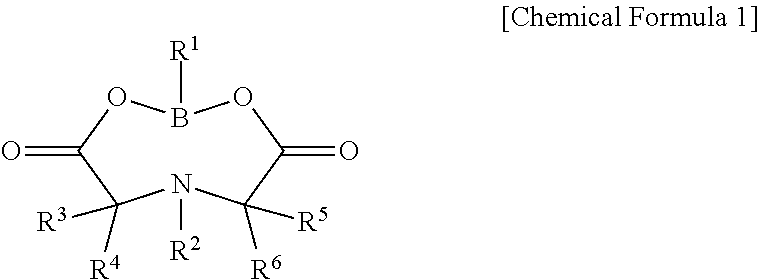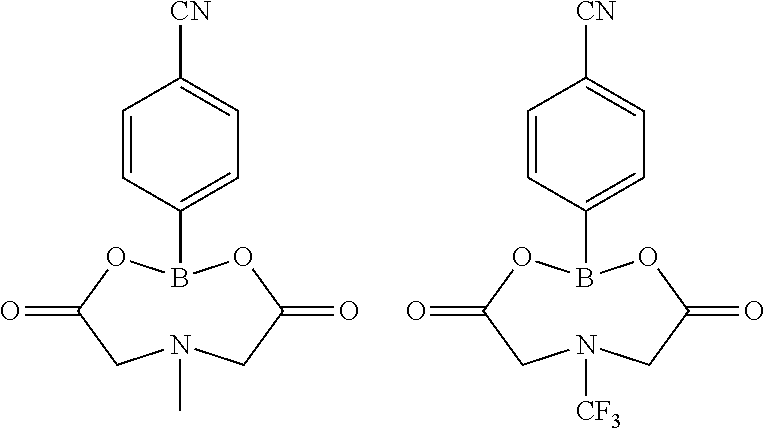Lithium secondary battery electrolyte and lithium secondary battery comprising same
a secondary battery and electrolyte technology, applied in the direction of positive electrodes, cell components, electrochemical generators, etc., can solve the problems of battery safety deterioration, battery may be ignited or ruptured, and the problem of increasing the difficulty of discharge, etc., to achieve excellent high temperature storage characteristics, improve the recovery rate of high temperature capacity, and reduce the effect of discharge capacity
- Summary
- Abstract
- Description
- Claims
- Application Information
AI Technical Summary
Benefits of technology
Problems solved by technology
Method used
Image
Examples
preparation example 1
[Preparation Example 1] Synthesis of 2,6-dimethyl-1,3,6,2-dioxazaborocane-4,8-dione (Hereinafter, Referred to as ‘PEA09’)
[0089]
[0090]After methylboronic acid (1.5 g) and N-(2-hydroxyethyl)iminodiacetic acid (3.7 g) were dissolved in a mixed solution (400 mL) of benzene / dimethylsulfoxide (9 / 1), a reaction was carried out for 12 hours while removing water by Dean-Stark distillation. After the reaction, benzene and dimethylsulfoxide were removed by reducing pressure at 100° C. to 1 to 5 mmHg using a vacuum pump. Thereafter, an unreacted material not removed was removed using column chromatography, thereby preparing 2,6-dimethyl-1,3,6,2-dioxazaborocane-4,8-dione (4 g).
[0091]1H NMR (CDCl3, 500 MHz) d 3.94 (d, J=16.5 Hz, 2H), 3.79 (d, J=16.5 Hz, 2H), 2.86 (s, 3H), 0.11 (s, 3H)
preparation example 2
[Preparation Example 2] Synthesis of 6-methyl-2-phenyl-1,3,6,2-dioxazaborocane-4,8-dione (Hereinafter, referred to as ‘PEA10’)
[0092]
[0093]After phenylboronic acid (3.0 g) and N-(2-hydroxyethyl)iminodiacetic acid (3.6 g) were dissolved in a mixed solution (400 mL) of benzene / dimethylsulfoxide (9 / 1), a reaction was carried out for 12 hours while removing water by Dean-Stark distillation. After the reaction, benzene and dimethylsulfoxide were removed by reducing pressure at 100° C. to 1 to 5 mmHg using a vacuum pump. Thereafter, an unreacted material that was not removed was removed using column chromatography, thereby preparing 6-methyl-2-phenyl-1,3,6,2-dioxazaborocane-4,8-dione (5.2 g).
[0094]1H NMR (CDCl3, 500 MHz) d 7.51 (m, 2H), 7.41 (m, 3H), 4.1 (d, J=17 Hz, 2H), 3.90 (d, J=17 Hz, 2H), 2.50 (s, 3H)
PUM
| Property | Measurement | Unit |
|---|---|---|
| volume ratio | aaaaa | aaaaa |
| voltage | aaaaa | aaaaa |
| temperature | aaaaa | aaaaa |
Abstract
Description
Claims
Application Information
 Login to View More
Login to View More - R&D
- Intellectual Property
- Life Sciences
- Materials
- Tech Scout
- Unparalleled Data Quality
- Higher Quality Content
- 60% Fewer Hallucinations
Browse by: Latest US Patents, China's latest patents, Technical Efficacy Thesaurus, Application Domain, Technology Topic, Popular Technical Reports.
© 2025 PatSnap. All rights reserved.Legal|Privacy policy|Modern Slavery Act Transparency Statement|Sitemap|About US| Contact US: help@patsnap.com



